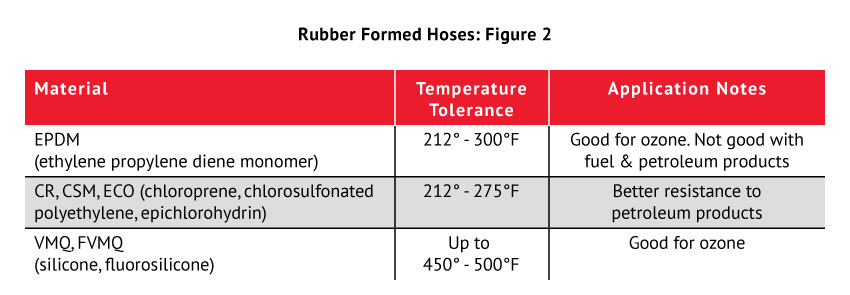From large vehicles to aquatic entertainment, rubber hoses are significant contributors to vibration absorption. Formed hoses are used in industries such as construction and power generation, and in consumer markets like lawn/garden, marine, and powersports.
Because hose production involves much labor, they are typically produced abroad, in countries such as China, India, and Taiwan. When supply chain issues arose in 2021-22, Molded Dimensions Group reaffirmed the value of producing hoses more regionally and of maintaining stock in nearby warehouses. And as a result, our customers see reduced lead times and reliable inventory for the quality, custom parts they receive.
The manufacture of rubber hoses begins with feeding rubber material into an extruder machine. A fabric reinforcement covers the newly formed rubber tube, and an additional layer of extruded rubber then covers the fabric. The tube’s outermost layer is labeled with ink, set by UV rays. After being washed and cut into lengths, the hose pieces are placed on shaped mandrels. These forms, with the rubber hose pieces, are placed in an autoclave, in which elevated heat and pressure are applied to the rubber. Once cured, the hoses are removed from the mandrels, washed, trimmed, and packaged.
Any material used to make a formed hose meets the SAE standards of J20R or J30R, which means manufacturers can rely on the material to have a uniform consistency and a typical formulation. Common materials used to make tubing, along with their applications, are listed in Figure 1.
 Several materials can be utilized for the fabric reinforcement layer of the rubber hose, depending on desired features and end-use application. Polyester is useful for cooling and intake hoses, which only experience low pressure. Conversely, Nomex® and Kevlar® are ideal for high-pressure, high-temperature situations, although they are more expensive. Both cotton and rayon (manufactured fiber made from wood pulp) can absorb and wick fluid, but they are also known to weaken the reinforcement. A final option is nylon, which is inexpensive, synthetic, and waterproof.
Several materials can be utilized for the fabric reinforcement layer of the rubber hose, depending on desired features and end-use application. Polyester is useful for cooling and intake hoses, which only experience low pressure. Conversely, Nomex® and Kevlar® are ideal for high-pressure, high-temperature situations, although they are more expensive. Both cotton and rayon (manufactured fiber made from wood pulp) can absorb and wick fluid, but they are also known to weaken the reinforcement. A final option is nylon, which is inexpensive, synthetic, and waterproof.
For a rubber hose’s cover material, one must bear in mind the environment in which the hose will be used. Figure 2 lists several options with usage considerations.
 Besides material selection, the shape of a hose’s ends should be thought about as well. Flared ends—created in the curing process by utilizing a mandrel with an enlarged end—offer many advantages, including:
Besides material selection, the shape of a hose’s ends should be thought about as well. Flared ends—created in the curing process by utilizing a mandrel with an enlarged end—offer many advantages, including:
- Greater clearance to surrounding components
- Installation depth control
- Increased burst pressure, with smaller inner diameter
- Less usage of extruded material
- Limited effects on flow by fitting
- Ability to implement tighter bend radii
- Option to employ standard extrusion tolerances and capped ends for control of outer diameter
- Opportunity to standardize on fewer extrusion diameters but with higher volume
The experts at Molded Dimensions Group guide each customer through these options in order to create their formed rubber hoses to match their needs. And no matter what selections are made, every product from Molded Dimensions Group is guaranteed to be of the highest quality. Reach out today to learn more.
Access more articles in our Rubber Knowledge Center.



